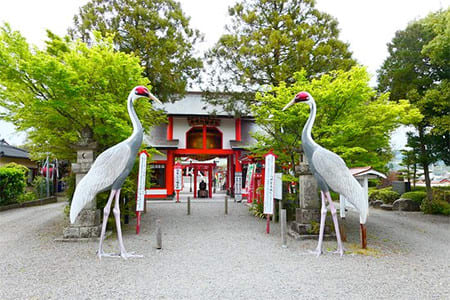


日本の神社には「狛犬」が付き物ですね。
建築としての神社というか、その空間性は好きなのですが、
必ずしも規格性とか統一性はないと一般的に言われます。
犬が一般的な意匠であることは疑いがないけれど、
イヌとは言っても、ほとんどライオンのようでもあり、
意匠性から考えると、エジプトのスフィンクスの普遍デザイン化とも思える。
神格に対してそれを守護して仕える存在ということなのでしょうか。
日本の古墳文化では中国の兵馬俑のような埴輪兵士像が一般的。
それとして意識的にとらえてきたことはなかったのですが、
ほとんど見るべきものがないかと思っていたCGグラフィックでの
東京国立博物館での北京故宮展示会で発見したのが上の写真。
なんと、鶴のワンペアが狛犬のように玉座左右に鎮座されている。
左右に離れて置かれている状態だったのですが、
画面上では近接させて一対の彫像をクルーズアップさせてみた。
こういう狛犬使用は、たしかいくつかの日本の神社建築でもみた記憶がある。
WEB上で調べてみたら、日本一の大鈴で有名とされる
鹿児島県出水の箱﨑八幡神社に下の写真のような狛犬。
中国北京の故宮、紫禁城の創立は以下のようなWiki記述。
〜1644年、明へ反旗を翻した李自成は北京を占領し紫禁城の一部を焼き尽くした。
しかし満州人・清王朝は李自成を北京から駆逐し紫禁城を再び修繕した。
火事から残された建物はそのまま明の時の漢民族風に維持し、
新しく改築された建物は満州風の特徴を加え、満漢両方特徴が揃った宮殿に。
その後、紫禁城は様式は変わらなく、現代に至る。〜
とされているようです。
一方の箱﨑八幡神社は島津家始祖の忠久が1180年代ころに創建の説。
時代相を考えると日本の現存「鶴」狛犬の方が古いのかも知れない。
故宮の方は1368年の明の建国時点で祖型がつくられたと考えても
日本の箱﨑八幡神社「鶴」狛犬に軍配が上がるのか。
まぁこういうことは検証のしようもないのですが、
東アジア世界では狛犬的風習がながく存在し続けてきたことは想像できる。
愛護的、もしくは神威をアピールする目的からライオンから鶴まで
モチーフはいろいろに変化しつつ、現代まで連なってきたのでしょう。
さて、現代世界ではアメリカのペロシ下院議長が訪台し、
そこから中国の国内情勢の緊張状態もあって戦争寸前の緊張が続いている。
中国の強権国家ぶりはアメリカに対しては張り子の虎に終始したが、
その汚名をそそぐというゆがんだ「中華皇帝」の暴走があり得る。と、見ていたら
日本のEEZ内海域に中国の実弾ミサイルが放たれた。
日米同盟としてどう対応するべきか?
国際関係最大の危険因子の動向に否応なく対応しなければならない。
危機に当たって冷静に毅然とした対応を祈念する次第。
English version⬇
Discovery of "crane guardian dogs" around the throne in the Palace Museum in Beijing
The decoration of "komainu" (guardian dogs) was universally practiced in the East Asian world. Furthermore, might they have their roots in the Sphinx? Stimulating the imagination. ...
Japanese shrines are accompanied by "komainu" (guardian dogs).
I like shrines as architecture, or rather their spatiality.
It is generally said that they are not necessarily standardized or unified.
Though there is no doubt that the dog is a common design
I would say it is a canine, but it almost looks like a lion.
In terms of design, it seems to be a universal design adaptation of the Egyptian sphinx.
Does it mean that it is a being that protects and serves a deity?
In Japanese tumulus culture, terra-cotta statues of soldiers like the Chinese terracotta warriors are common.
I have never consciously regarded them as such.
I had wondered if there was almost nothing to see in the CG graphics.
The photo above was discovered at the Beijing Palace Museum exhibition at the Tokyo National Museum.
To my surprise, one pair of cranes are seated on either side of the throne like komainu (guardian dogs).
They were placed far apart on the left and right sides.
On the screen, I brought them closer together and cruised up the pair of statues.
I remember seeing this kind of use of komainu in some Japanese shrine buildings.
I found on the web that there is a shrine in Hakozaki, Izumi, Kagoshima Prefecture, which is famous for its large bell, the largest in Japan.
I found on the web that Hakozaki Hachiman Shrine in Izumi, Kagoshima Prefecture, which is famous for the largest bell in Japan, has a guardian dog like the one in the photo below.
The Forbidden City, a palace in Beijing, China, was founded in 1644, according to the following Wiki article.
〜In 1644, Li Jicheng's army, rebelling against the Ming Dynasty, occupied Beijing and burned a part of the Forbidden City.
However, the Manchu and Qing dynasties drove Li Jisheng out of Beijing and rebuilt the Forbidden City.
The buildings that survived the fire were maintained in the Han Chinese style of the Ming Dynasty, while the newly renovated buildings were restored in the Manchu style.
The newly reconstructed buildings were given Manchu features, creating a palace with both Manchu and Han characteristics.
The style of the Forbidden City remained unchanged until the present day. 〜The Forbidden City is said to have been built in the Manchurian style.
The Forbidden City is said to have been built in the same style as the Forbidden City.
Hakozaki Hachiman Shrine, on the other hand, is said to have been built around the 1180s by Tadahisa, the founder of the Shimazu family.
Considering the period, the existing "crane" guardian dogs in Japan may be older.
The NPM may be considered to have been ancestral at the time of the founding of the Ming Dynasty in 1368, but it is not clear whether this is the case or not.
Does this mean that the "crane" guardian dogs of the Hakozaki Hachiman Shrine in Japan are older than those of the NPM?
Well, there is no way to verify this.
We can imagine that in East Asia, the custom of using guardian dogs has been in existence for a long time.
The motifs have varied from lions to cranes, but the modern-day guardian dogs have always been a symbol of the gods' power and authority.
The motifs have changed in various ways, and have continued to the present day.
Now, in the modern world, we are witnessing the visit of U.S. Speaker of the House Pelosi to Taiwan.
The tension in the world today is on the verge of war due to the visit of US Speaker Pelosi to Taiwan and the tense domestic situation in China.
China's powerful state has been a tiger in the face of the U.S., but it is now on the verge of war.
The warped "emperor of China" who wants to clear his name could go out of control. And, if we were to look at it.
A live Chinese missile was released into Japan's EEZ.
How should we respond as the Japan-U.S. alliance?
We must respond to the trend of the greatest risk factor in international relations without hesitation.
I pray for a calm and resolute response to the crisis.



















